|
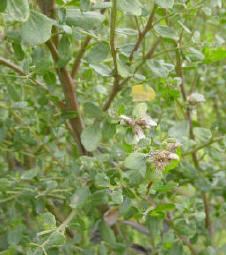 Coyote Brush Coyote Brush
Family Asteraceae
(aster)
Baccharis pilularis
Coyote brush
is an evergreen shrub that grows up to 4 meters in this area. Male
and female flowers are borne on separate plants in late fall. The
yellow pollen of the male flower smells like shaving soap. Early
Californians, because of its abundant silky-haired seeds, called
coyote brush “fuzzy-wuzzy”. Coyote brush is an important pioneer
species in the process of plant succession. It is usually the first
shrub to appear in a grassy field after vegetation has been removed
by cultivation or fire.
|
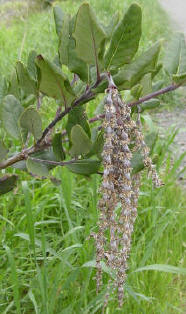  Coast Silk-tassel Coast Silk-tassel
Family Garryaceae
Garrya elliptica
Evergreen shrubs or small trees.
Leaves are leathery with wavy edges. They are arranged in opposite
pairs and are dark shiny green above; gray below with dense,
microscopic hairs. Male and female catkins are borne on separate
plants. The male catkin is long with slender chains of “bells.”
|
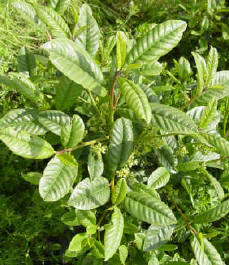 Coffee Berry Coffee Berry
Family Rhamnaceae (buckthorn)
Rhamnus californica
Low lying,
medium to large evergreen shrub, found in the Coast Ranges. Coffee
berry bears black fruits that gives the name of coffee berry to most
species. Clusters of berries are green, ripening to orange-red and
finally black. The young leaves are lighter green and mature to dark
green. Edges curl under during dry summers to conserve moisture.
Flowers are white with a star shape, emerging from green buds in
clusters.
|
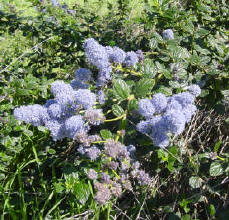 California
Lilac California
Lilac
Family Rhamnaceae (buckthorn)
Ceanothus griseus
Shrubs or
small trees, with white to blue flowers that are small but showy.
The inflorescence varies with each species With few exceptions they
are evergreen. There are 43 species native to California from the
coast to the Sierras. This species can spread to 1-3 meters and
found in coastal California.
|
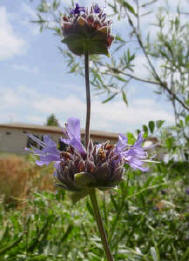 Musk Sage Musk Sage
Family Lamiaceae (mint family)
Salvia clevelandii
An evergreen shrub with lavender flowers. It
can grow to 1-1.5 meters. The grey- green leaves have an intense
smell. Leaves are lancelate about 3 cm long, serrated with a
coarse feel. It blooms from spring to late fall. Common in
chaparral areas to about 3000 feet.
|
 Black Sage Black Sage
Family Lamiaceae (mint family)
Salvia mellifera
A 1-2 meter
high, erect, open branched perennial shrub, with elliptical oblong
leaves with fine hairs. Foliage has a distinct aromatic fragrance
that gives a minty smell when crushed. The pinkish white flowers are
spaced 1-2 cms apart in compact whorls. Black sage is named because
the dried flowers remain on the stems at the end of the season and
turn black. Common shrub on dry slopes in lower than 2000 feet.
|
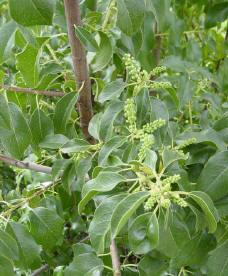 Hollyleaf Cherry
Family Rosaceae (rose)
Prunus ilicifolia Hollyleaf Cherry
Family Rosaceae (rose)
Prunus ilicifolia
Dense,
evergreen that is uniformly branched. Leaves are ovate to
round, thick, glossy, rich, bright green, with spine-toothed on
margins. Most leaf blades are less than 3 times as long as
wide. Flowers are small, white and borne in
elongated racemes. Fruit is juicy, 12-25 mm long, red to
blue-black. Indians used large seeds to make flour.
|
|
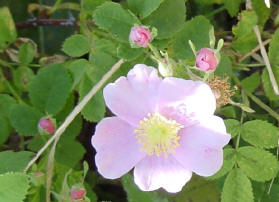 California Rose California Rose
Family Rosaceae (rose)
Rosa californica
California
rose often forms thickets in moist places that provide cover and
food for birds and small mammals. Rose stems have prickly stems and
compound leaves. The single 2 to 3-inch flowers have fragrant
rose-pink petals. The glossy red/orange rose “hips” surrounding the
fruits are a rich source of Vitamin C. They are used to make jam,
tea, fruit leather, soup and syrup.
|
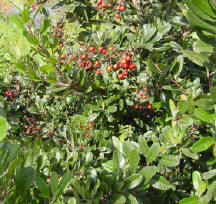 Toyon Toyon
Family Rosaceae (rose)
Heteromoles arbutifolia
Large
evergreen shrub or small tree, 6-10 ft tall. It has brilliant red
berries in the winter. Leaves are dark green, serrated. Flat
cluster of small white flowers. Drought tolerant plant.
|
|
 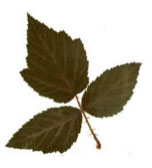 California Blackberry California Blackberry
Family Rosaceae (rose)
Rubus ursinus
This native woody shrub is commonly found in woodlands and parks.
These plants produce a berry that is black to dark purple in color
when ripe. The compound leaves are composed of three leaflets and
blooms in late March to April. The branches are covered with small,
needlelike thorns. These vines grow best in moist soil of a
wetland.
|